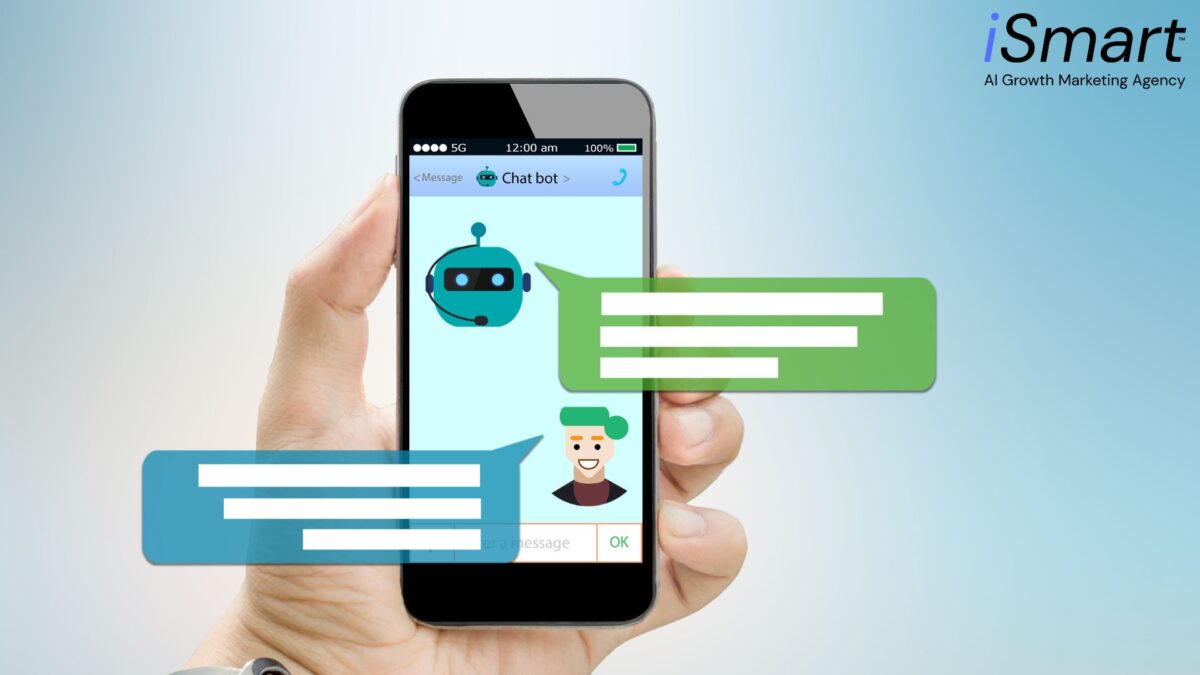AI Chatbots and Customer Engagement: Revolutionizing Customer Service
October 17, 2024Transform Your Marketing Game: 7 AI Techniques You Haven’t Tried Yet
October 23, 2024Artificial Intelligence (AI) is no longer the future—it’s here, and it’s reshaping the marketing landscape at an unprecedented pace. Businesses of all sizes are using AI to streamline processes, create more targeted campaigns, and enhance customer experiences. But with so many advancements, it can be tough to keep up. If you’re not staying on top of the latest AI trends, you risk falling behind your competition.
In this blog post, we’ll walk you through 7 game-changing AI marketing trends that are set to revolutionize how businesses operate. These trends aren’t just buzzwords; they’re practical tools that can help drive growth, improve efficiency, and transform your marketing strategy. Let’s dive in and see how AI can take your marketing efforts to the next level.

Hyper-Personalization Through AI-Driven Insights
Hyper-personalization has become a critical tool for marketers aiming to provide highly relevant and individualized customer experiences. While traditional personalization might involve addressing a customer by name in an email or recommending products based on previous purchases, hyper-personalization takes it several steps further. It leverages AI to analyze vast amounts of customer data, including real-time behavior, preferences, interactions, and past purchasing decisions. The result is the ability to create ultra-targeted marketing messages that resonate on a deeply personal level.
The key to hyper-personalization is the use of AI-powered algorithms that can analyze consumer data at a speed and scale that no human team could manage. These algorithms examine a wide range of factors—like browsing habits, previous engagement patterns, social media interactions, and purchasing history—to predict what a customer might want or need next. This allows businesses to create marketing campaigns that evolve in real-time, adapting to a customer’s latest actions or preferences.
A classic example of hyper-personalization can be seen in dynamic email marketing campaigns. Instead of sending a one-size-fits-all newsletter, businesses can use AI to tailor each email to the recipient’s unique interests. For instance, if a customer recently browsed a particular product but didn’t make a purchase, the next email they receive could feature that product at a discounted price or highlight similar items. By addressing individual needs so precisely, businesses can significantly increase open rates, click-through rates, and conversions.
Similarly, AI-driven hyper-personalization is transforming the world of e-commerce product recommendations. Platforms like Amazon use AI to suggest products based on detailed user profiles, improving the likelihood of purchases. If a customer frequently buys tech gadgets, for example, the website may showcase the latest gadgets or accessories that complement previous purchases. This tactic can also be seen in media platforms like Netflix, where personalized content recommendations are driven by AI algorithms analyzing viewing history, preferences, and even the time of day a user is most active.
One of the most significant benefits of hyper-personalization is the impact it has on customer loyalty and engagement. When customers feel like a brand understands them on a personal level, they’re more likely to remain loyal. This increases customer retention rates and enhances lifetime value. Hyper-personalization also boosts engagement metrics because customers are more inclined to interact with content that feels tailored to their needs.
Furthermore, the impact on conversion rates cannot be overstated. Personalized messages and offers are far more likely to lead to sales than generic ones. When a brand delivers the right message at the right time, it’s easier to convince the customer to act, whether it’s making a purchase, signing up for a newsletter, or engaging with content.
In conclusion, hyper-personalization through AI-driven insights is revolutionizing marketing by offering an unprecedented level of precision and relevance. Brands that can master this technology will not only boost their customer engagement but also build lasting relationships that drive long-term success.

AI-Powered Content Creation and Automation
Content creation has always been a central pillar of marketing, but the process of consistently generating high-quality content can be time-consuming and resource-intensive. That’s where AI-powered content creation comes into play, revolutionizing how businesses approach the task. AI tools can now automate the creation of blog posts, social media updates, video scripts, and even more complex pieces like reports and whitepapers.
At the core of AI-powered content creation is Natural Language Processing (NLP), a branch of AI that allows machines to understand, interpret, and generate human language. NLP enables AI content creation tools like Jasper, Copy.ai, and Writesonic to analyze massive datasets of text. These tools learn the patterns of language, including tone, style, structure, and grammar, which allows them to generate written content that is not only coherent but also engaging and on-topic.
One of the most practical applications of AI content creation is in generating SEO-optimized blog posts. By analyzing existing top-ranking content for specific keywords, AI tools can create new articles designed to rank well in search engines. This speeds up the SEO content creation process and ensures that businesses can maintain a consistent output of optimized articles, blogs, or landing pages.
Another area where AI-powered content creation excels is in producing social media updates. Social platforms require a constant stream of fresh content to stay relevant, but writing new posts daily can be challenging for many businesses. AI tools can create short-form content, such as social media posts, that align with the brand’s voice while ensuring engagement with followers. For example, a brand launching a new product can use AI to create multiple variations of a post, each with slightly different messaging, to appeal to different audience segments or to avoid redundancy in its posting schedule.
Moreover, these AI tools can even help businesses create long-form content like eBooks, reports, and whitepapers. In industries where in-depth research and technical writing are required, AI can assist in structuring the content, generating initial drafts, and optimizing them for readability and SEO. Businesses can save time and resources, allowing their human teams to focus on high-level strategic tasks rather than the manual labor of content creation.
The benefits of AI-powered content creation go beyond efficiency. The use of AI ensures consistency across all platforms, meaning that businesses can adhere to their content calendar without delays. Furthermore, AI-generated content is continuously improving, as these tools learn from every interaction, refining their output to better match the brand’s tone and audience preferences over time.
In summary, AI-powered content creation is transforming how businesses approach content marketing by automating the generation of high-quality, relevant, and SEO-optimized material. This not only saves time and increases productivity but also ensures that businesses can maintain a strong, consistent presence across all digital channels.

Predictive Analytics for Smarter Campaigns
Predictive analytics is becoming an indispensable tool for marketers who want to move beyond reactive strategies and start anticipating customer needs and trends. Powered by AI, predictive analytics uses historical data, statistical algorithms, and machine learning to make educated predictions about future customer behavior. This technology allows marketers to shift from a reactive to a proactive approach, enabling them to optimize campaigns, predict customer churn, and anticipate future trends.
At its core, predictive analytics involves the use of AI algorithms to analyze vast datasets. These datasets might include past customer interactions, purchase history, website engagement, social media activity, and even external factors like market trends or economic conditions. By identifying patterns and correlations in this data, predictive models can forecast a wide range of outcomes, from which products are likely to sell in the future to which customers are at risk of abandoning their relationship with the brand.
One of the most common applications of predictive analytics in marketing is customer churn prediction. Churn, or the rate at which customers stop engaging with a company, is a critical metric for many businesses. By analyzing customer behavior patterns, AI can identify which customers are most likely to churn and why. For instance, customers who haven’t interacted with the brand in a while, or those who have shown dissatisfaction through customer service interactions, might be flagged by the predictive model. With this insight, businesses can proactively reach out to at-risk customers with tailored offers or incentives to re-engage them.
Another powerful application of predictive analytics is in demand forecasting. This is particularly useful for retailers and e-commerce platforms that need to manage inventory levels and anticipate future sales. AI models can predict which products will see increased demand in the coming months based on factors like seasonality, economic trends, and customer preferences. Armed with this information, businesses can adjust their inventory, plan marketing campaigns, and optimize supply chains to meet expected demand.
Ad targeting is another area where predictive analytics shines. Traditional digital advertising often involves casting a wide net in the hopes of reaching potential customers. However, predictive analytics allows marketers to use data to target ads with laser precision. By analyzing historical data on customer behavior and ad performance, AI models can predict which audiences are most likely to respond to specific ads. This means that businesses can allocate their ad spend more effectively, showing their ads only to the people who are most likely to convert.
The benefits of predictive analytics are profound. First and foremost, it leads to better decision-making by giving marketers actionable insights based on real data rather than intuition. This allows for more efficient use of resources, whether it’s in ad targeting, inventory management, or customer engagement. Second, predictive analytics improves the return on investment (ROI) by ensuring that marketing efforts are directed toward the most profitable opportunities. Finally, predictive analytics helps optimize customer experiences by ensuring that each interaction is as relevant and personalized as possible.
In conclusion, predictive analytics is a game-changer for marketers looking to make data-driven decisions. By leveraging AI to anticipate future trends and behaviors, businesses can create smarter, more effective marketing campaigns that drive engagement, retention, and growth.

AI-Driven Chatbots for Enhanced Customer Service
In the fast-paced digital world, customers expect immediate responses and 24/7 availability. Meeting these demands while maintaining efficiency is a challenge for many businesses, which is why AI-driven chatbots have become an essential tool in customer service. These advanced chatbots are revolutionizing how companies engage with their customers, providing real-time, personalized support while freeing up human resources for more complex tasks.
AI-powered chatbots rely on Natural Language Processing (NLP) to understand, process, and respond to customer queries in a human-like manner. These systems analyze the customer’s input, identify the intent behind the question, and generate an appropriate response. Over time, the chatbot’s responses improve as it learns from customer interactions, making it better equipped to handle a wide range of inquiries.
One of the key advantages of AI chatbots is their ability to offer 24/7 customer support. In traditional setups, businesses either need to have human agents working in shifts or risk leaving customers unattended outside regular working hours. With AI-driven chatbots, customers can get immediate answers to their questions at any time of day, significantly improving customer satisfaction. Whether it’s helping customers with order tracking, answering frequently asked questions, or providing product recommendations, these chatbots can do it all without any downtime.
An example of effective chatbot integration can be seen in e-commerce websites that use AI-powered assistants to help customers navigate the buying process. Suppose a customer is browsing an online store but can’t decide between two products. The chatbot can step in, asking a few questions about the customer’s preferences and offering recommendations based on previous purchases or popular trends. If the customer needs further assistance, the chatbot can even escalate the issue to a human agent, ensuring a seamless experience.
Another popular use case is seen in integration with messaging apps like WhatsApp, Facebook Messenger, and Slack. Businesses are leveraging AI chatbots to provide instant customer support within platforms that users already frequent. This simplifies the customer experience, as they don’t need to navigate to a different website or app to get help. These chatbots can manage everything from answering simple queries to booking appointments, making them incredibly versatile.
AI chatbots also offer businesses a cost-effective customer service solution. By handling a large portion of customer inquiries automatically, companies can reduce their reliance on large human support teams. This allows them to allocate resources more efficiently and focus on higher-priority tasks, such as handling complex customer issues or developing new strategies for growth. Additionally, AI chatbots can manage an unlimited number of conversations simultaneously, meaning no customer has to wait in a queue for assistance.
For businesses looking to enhance the customer journey, AI chatbots offer a powerful way to improve customer satisfaction. By providing instant, accurate, and helpful responses, chatbots can reduce frustration and improve the overall user experience. Customers appreciate the convenience of getting their issues resolved quickly, and businesses benefit from higher engagement, customer loyalty, and reduced churn rates.
In conclusion, AI-driven chatbots are transforming customer service by providing instant, scalable, and cost-effective solutions. They enable businesses to meet the growing demand for 24/7 support while ensuring customers receive personalized and efficient service. As chatbot technology continues to evolve, businesses that adopt this AI trend will be better equipped to keep their customers satisfied in a highly competitive market.

Visual and Voice Search Optimization
As search behavior evolves, businesses must adapt to new technologies that are changing how people find information online. Two of the most significant shifts in recent years are the rise of visual and voice search. Powered by AI, these search methods are reshaping how users interact with the internet, and optimizing for them is becoming increasingly important for businesses looking to maintain and grow their online presence.
Visual search allows users to search the web using images instead of text. For example, if someone takes a photo of a specific product, AI-powered visual search engines can analyze the image and provide relevant results, such as where to buy the product or similar items. Tools like Google Lens and Pinterest Lens are at the forefront of this trend, using image recognition technology to help users find information based on the objects in their photos.
Optimizing for visual search means that businesses must ensure their product images are highly searchable. This involves implementing structured data (metadata) on images, optimizing alt-text descriptions, and ensuring that images are of high quality. E-commerce brands, in particular, can benefit from visual search optimization by making it easier for potential customers to find their products through images. By doing so, businesses can reach users who may not have known the product name but were attracted by its visual appearance.
Voice search, on the other hand, has exploded in popularity due to the rise of AI-powered voice assistants like Siri, Alexa, and Google Assistant. Rather than typing their queries, users can now speak them, allowing for a more natural and hands-free search experience. Voice search is particularly popular for mobile users and in-home devices like smart speakers. In fact, research shows that over 50% of all searches are now conducted via voice, making it crucial for businesses to optimize their content for this growing trend.
To optimize for voice search, businesses need to focus on conversational keywords and natural language. Voice search queries tend to be longer and more conversational than text-based searches, often resembling full questions. For instance, instead of typing “best pizza in New York,” a user might ask, “Where can I find the best pizza near me?” This means businesses must create content that answers these types of conversational queries directly. Using long-tail keywords and focusing on FAQ-style content can significantly improve a brand’s visibility in voice search results.
Both visual and voice search optimization share a common goal: enhancing search engine visibility. For businesses, the benefits of optimizing for these AI-driven search methods are clear. First, it allows companies to reach a broader audience by capturing searchers who may prefer visual or voice queries over traditional text-based searches. Second, optimizing for these search trends can improve a company’s search engine rankings, helping them to appear higher in search results and drive more organic traffic to their website.
Moreover, businesses that embrace visual and voice search optimization can provide a better user experience. Visual search makes it easier for customers to find products based on appearance, while voice search allows for more convenient, hands-free interactions. Both methods enable faster and more efficient searches, making it easier for users to find what they’re looking for.
In summary, AI-driven visual and voice search optimization is an essential trend that businesses cannot afford to ignore. By adapting to these new search behaviors, companies can increase their reach, improve user experiences, and enhance their search engine performance, ensuring they stay competitive in the evolving digital landscape.

AI-Powered Programmatic Advertising
Programmatic advertising has transformed the way digital ads are bought and placed. Gone are the days of manually negotiating ad placements—AI-powered programmatic advertising automates the process, making it faster, more efficient, and data-driven. This type of advertising leverages AI to manage the buying and selling of ads in real-time, optimizing ad placements based on performance and ensuring that the right message reaches the right audience at the right time.
At its core, programmatic advertising relies on AI algorithms to handle the ad bidding and placement process. When a user visits a website, AI systems instantly analyze their behavior, demographics, and preferences. Based on this analysis, the AI determines whether the user fits the target audience for a particular ad and bids for the ad space in a real-time auction. If the bid is successful, the ad is displayed to the user—all within milliseconds.
Platforms like Google Ads, Facebook Ads, and The Trade Desk use programmatic advertising to deliver highly targeted ads across websites, social media platforms, and mobile apps. For example, if a user has shown interest in travel by visiting vacation booking sites, programmatic advertising systems can automatically serve them relevant ads for hotels, flights, or travel deals, increasing the likelihood of conversion.
One of the main benefits of AI-powered programmatic advertising is real-time optimization. Traditional advertising campaigns often require marketers to manually analyze performance data and adjust their strategies. With programmatic advertising, AI handles this process automatically, continuously optimizing campaigns based on metrics like click-through rates, conversion rates, and user engagement. This ensures that ad spend is used efficiently, minimizing waste and maximizing return on investment (ROI).
Additionally, programmatic advertising enables increased ad relevance. By leveraging vast amounts of user data, AI can ensure that ads are tailored to individual preferences, interests, and behaviors. This level of personalization increases the likelihood that users will engage with the ads they see, leading to higher conversion rates. It also reduces the risk of ad fatigue, as users are less likely to be bombarded with irrelevant ads.
Moreover, programmatic advertising offers scalability. AI can manage hundreds or even thousands of campaigns simultaneously, adjusting bids, targeting options, and ad placements in real-time. This allows businesses to reach large, diverse audiences without the need for manual intervention. Whether a company is running a small local campaign or a global advertising strategy, AI-powered programmatic advertising can scale to meet its needs.
In conclusion, AI-powered programmatic advertising is revolutionizing digital marketing by automating the ad buying process and optimizing campaigns in real-time. Businesses that adopt this technology can benefit from increased efficiency, better ad targeting, and improved ROI, making it a must-have tool for modern marketers.

Ethical AI and Data Privacy
As AI becomes more integrated into marketing, concerns about data privacy and ethical AI usage are growing. Consumers are increasingly aware of how their data is being used, and businesses must ensure that they handle personal information responsibly to build trust and avoid legal repercussions. Ethical AI and data privacy are not just about compliance—they are also about maintaining the trust and confidence of customers.
AI systems often rely on large amounts of data to deliver personalized experiences and targeted marketing campaigns. However, this raises questions about how data is collected, stored, and used. In recent years, regulations like the General Data Protection Regulation (GDPR) in Europe and the California Consumer Privacy Act (CCPA) in the U.S. have set strict guidelines on how businesses can use personal data, requiring greater transparency and control for consumers.
Businesses need to be proactive in ensuring that their AI systems comply with these regulations. This includes implementing transparent data collection practices, obtaining explicit consent from users before collecting personal information, and providing options for users to opt-out of data collection. Furthermore, companies must ensure that they are not using biased or discriminatory AI algorithms, as this could lead to unfair treatment of certain groups of people, damaging a brand’s reputation.
Ethical AI usage also involves ensuring that AI systems are transparent and explainable. Consumers should have a clear understanding of how AI decisions are made, especially when it comes to sensitive issues like credit scoring, hiring, or insurance. By providing transparency in AI decision-making processes, businesses can build trust with their customers, ensuring that they feel comfortable with the ways in which their data is being used.
In conclusion, ethical AI and data privacy are critical considerations for businesses using AI in their marketing efforts. By prioritizing transparency, fairness, and compliance with regulations, companies can build trust with their customers and mitigate the risks associated with AI-driven marketing strategies.
Conclusion
In today’s rapidly evolving digital landscape, the integration of AI marketing trends is no longer a luxury but a necessity for businesses looking to stay competitive. From hyper-personalization to AI-powered chatbots, these cutting-edge trends are transforming how businesses engage with customers, make decisions, and drive growth. AI allows marketers to tap into data-driven insights, automate repetitive tasks, and optimize marketing efforts, leading to improved efficiency, customer satisfaction, and ROI.
As we’ve explored throughout this post, embracing these seven game-changing AI marketing trends can unlock new opportunities for businesses. Whether it’s predictive analytics for smarter campaigns or the rise of visual and voice search optimization, staying ahead of these trends ensures that businesses are not just keeping up with the competition but leading the way in innovation.
Moreover, with the growing importance of ethical AI and data privacy, companies must adopt AI responsibly to build trust with their consumers and remain compliant with global regulations. By doing so, businesses safeguard their reputations and foster long-term customer relationships, all while harnessing the power of AI to revolutionize their marketing strategies.
The future of marketing is undeniably AI-driven, and those who adopt these trends now will be better positioned to future-proof their strategies, enhance their customer experiences, and drive sustained business growth.


